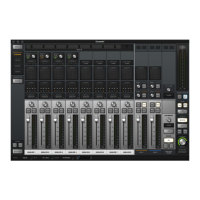Apollo Thunderbolt Software Manual Device Drivers 202
Device Drivers
Apollo Drivers Overview
The Apollo device drivers are the low-level software files that instruct the computer’s
operating system on how to communicate with the Apollo hardware. The drivers are
loaded during system startup so that whenever Apollo is connected, the device is ready
to accept instructions from the OS. Apollo’s drivers control Apollo’s audio interface,
Console, and UAD-2 functionality.
Core Audio & ASIO
Apollo’s audio drivers use the Core Audio (Mac) and ASIO (Windows) APIs. Apollo’s
normal (non-DSP) audio interface features are simply seen as a Core Audio / ASIO
device; therefore any Core Audio / ASIO compliant software can use Apollo for audio I/O.
UAD Mixer Engine
The Console application and Console Recall plug-in don’t actually communicate directly
with Apollo. Instead, they communicate with the UAD Mixer Engine, which is the central
software hub for all Console and Console Recall functionality. The UAD Mixer Engine
behaves as a server for Apollo’s internal DSP mixer that runs in the background, so
Console does not have to be open for Apollo to function.
The UAD Mixer Engine is a system-level application that is automatically launched
during system startup and is always running during normal operation. The UAD System
Menu is it’s only interface, which can be accessed from the Menu Bar (Mac), or the
Windows System Tray (Windows).
Driver I/O Complement
The specific inputs and outputs that are available to the DAW depends on the active
configuration. The I/O complement changes at high sample rates and when multi-unit
cascading. The specific I/O complements can be customized in the I/O Matrix Panel.
Default I/O values are listed in the Driver I/O Tables in this chapter.
Driver Names and Numbers
Apollo’s drivers describe all I/O channels by name and number, but what is actually
displayed in the DAW’s I/O assignment lists depends on each particular DAW. Names
are not displayed by all DAWs (e.g., Ableton Live), or the driver name display mode may
need to be changed in the DAW (e.g., Apple Logic Pro).
Virtual I/O
Apollo’s device drivers carry various virtual (software only) input and output channels in
addition to those directly associated with the hardware inputs and outputs. The virtual
channels consist of all of Apollo’s bus outputs (the main monitor mix and all channel
send mixes) and Console’s virtual inputs. Virtual I/O facilitates highly flexible signal
routing via the DAW. See Virtual I/O for details about this feature.

